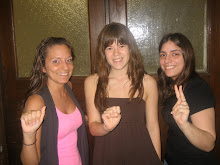Hello! Welcome to our blog “A.S.K. ASL” by Amanda Boyle, Sarah Drake and Kerry Daley from the Teaching American Sign Language as a Foreign Language program at Teachers College, Columbia University.
When we asked ourselves how we are personally going to affect change in our future classrooms, we found our discussions continually returning to the question of how are we going to incorporate Deaf awareness into our American Sign Language (ASL) classes? Broadly speaking, Deaf culture is less familiar to the “general” hearing public then, for instance, French culture. Why is that? Well, one reason would be size. According to the National Association of the Deaf, (2009), approximately 36,000,000 people in America identify as deaf, late deafened, deaf-blind or hard of hearing. That’s about 17% of the U.S. population. Furthermore, for each deaf individual, there might be a handful of friends and family members in their lives who could be recognized as “allies.” That leaves a huge part of the hearing world that may never have met a deaf person, let alone been exposed to American Sign Language or Deaf culture. Therefore, it is safe to assume that many of our future students would belong to the latter category.
First, we decided to tackle the areas about deaf culture that people apparently do not know. We brainstormed the most common questions we are asked about our field of study, and the following is a compilation of the questions we receive the most:
- Is ASL a “real” language?
- Is ASL universal? Is there a universal sign language?
- Is it the same language that Native Americans used?
- Isn’t it really easy?
- Why do deaf people sign? Why don't they just read lips?
- Have you taken any lip-reading classes?
- Do you know Braille too?
Also, we’ve been asked several questions about deaf people themselves:
- How do you learn if you are deaf or hard of hearing?
- How do deaf people use the telephone?
- How is deafness a culture?
Now, our point is not to dwell on any sort of majority culture ignorance, but instead to highlight that Deaf culture is an area that we feel many people are unfamiliar with. Our goal then, is to sufficiently cover these areas in our curriculum so our students not only know the answers themselves, but also can provide thorough answers to them long after they have left our classroom.
How can we do that? Clearly, Deaf awareness in the ASL classroom needs to be a constant and daily element to the curriculum, not just one stand-alone chapter or section in the class. Therefore, we want to provide our class with an additional pathway to allow for student inquiries and information about Deaf culture outside of the classroom. This blog will serve as a forum to be available to our students at all times, where us as teachers can post videos, related-news articles, and other information. This would also be an area that questions can be posted, at any hour, and answered as quickly as possible.
Our hope is that this can be a forum where misconceptions about the Deaf community can be addressed and clarified.
